by Prof.
David N. Nikogosyan, University College Cork, Cork, Ireland
(click on photos to enlarge image)
MARKS OF EUROPEAN SILVER PLATE:
II. FRAGET & NORBLIN, POLAND/RUSSIA
Visiting Moscow in 2000, I bought a strange silver-plated
object at the antique market "Izmailovo". A rather small
container in the form of a traditional wooden Russian barrel
with two compartments inside; the upper one bearing a glass
inset, was placed on the silver-plated dish and covered by the
lid. All three parts (the container, the lid and the dish) were
marked by the same monogram AH (AN in Russian). Many of my
Russian friends and colleagues could not recognise the purpose
of this object. It took me a lot of time before I understood
what it was for - it was a caviar holder.
A caviar holder made by Fraget between
1896-1915 and its parts.
|
Indeed, the caviar is a rather delicate product, easily
deteriorating at room temperature. At that time there were no
refrigerators, and to protect the caviar the ice was placed in
the lower compartment of the container under the glass inset
with the caviar. The maker mark easily readable on the container
and on the dish was “FRAGET”. Interestingly, a double-headed
eagle (the Russian coat of arms) was placed above the mark.
After further investigation I recognised that this caviar holder
was made in Warsaw (Warszawa), which in the XIX century was the
capital of the Polish Kingdom (Królestwo Polskie), an autonomous
region inside the Russian Empire. At the end of the XIX century
most of the Russian silver plate production was concentrated in
Poland, and about ten foundries producing silver plate were
operating in Warsaw. Among them the most interesting Art Nouveau
objects were produced by “FRAGET” and by another Warsaw foundry,
“NORBLIN”. Below are the photographs of some Polish/Russian
silver-plated items in Art Nouveau style from my collection.
A teapot and a coffee-pot made by Fraget
between 1896-1915.
|
A milk-pot and a tea-glass holder made
by Fraget between 1872-1896.
|
A pair of milk-pots and a coffee-set
made by Norblin in the beginning of XX century.
|
Now a few words about the history of
such a fruitful Polish/Russian trade. The Fraget factory was
founded by two French businessmen – the brothers Alphonse (Alfons)
and Joseph (in Polish, Józef) Fraget in 1824. However, after
1841 Joseph Fraget became the sole owner of this company. In the
fifties-sixties of the XIX century, the firm turned to the
production of electroplated silver items and exported them
mainly to the Russian market. The products of the Fraget firm
soon turned out to be extremely popular. Since, any
silver-plated item in the Russian Empire was called simply “fraget”.
In 1867 Joseph Fraget died, and his business was inherited by
his son Julian. In 1905, Julian was assassinated and from 1906
Fraget was managed by Julian’s daughter, Maria Antonina, who
died in 1934. In 1939 with the start of World War II, the Fraget
company stopped its activity.
The Norblin factory was founded in 1809 by the goldsmith Filip
Vorbrodt, who came to Warsaw from the small Anhalt Principality
in Germany. His daughter, Henriette Leopoldina Augusta, first
married the French silversmith Jean Cerisy and then (after her
hudband’s death in 1831) another French jeweller Vincent (in
Polish, Wincenty) Norblin, the son of Alexander Jean Norblin,
owner of a bronze factory in Warsaw. Vincent Norblin (1805-1872)
significantly increased the production of silver and bronze
items and organised the silver plating. In 1865 he sold the
factory to his son Ludwig (in Polish, Ludwik) Norblin (1/2 of
the whole capital), daughter Albertina Wilhelmina (1/4 of the
whole capital) and her husband A. Teodor Werner (1/4 of the
whole capital), who was the owner of another silver foundry in
Warsaw. After that, Ludwig Norblin and Teodor Werner united
their factories in one large company NORBLIN i Ska (NORBLIN i
Spó-ka), which means in English NORBLIN & Co. However, they
continued to work separately, Ludwig Norblin was producing
electroplated silver items, while Teodor Werner worked with
sterling silver items. In 1872 Ludwig Norblin (1836-1914) bought
a silver plate company from Buch Brothers. In 1893, he organized
a new public company Norblin, Buch Brothers & T. Werner . Like
Fraget, Norblin company also successfully survived World War I,
but stopped production in 1939.
Below, I am presenting silver plate marks of Fraget and Norblin
factories, issued in the XIX - XX centuries.
Fraget marks (according to the
classification given by Svetlana Chestnykh with my additions and
changes)
|
N°
|
PERIOD
|
FRAGET MARK
|
COMMENT
|
1
|
1840-1851
|
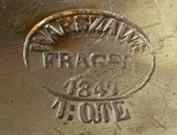 |
Marked by the inscription "WARSZAWA FRAGET" + the
year of production, placed in the oval. 1:QTE (1:QUALITE)
means 1st QUALITY (in French).
|
2
|
1851-1859
|
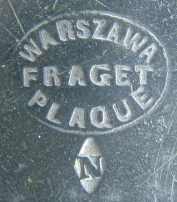 |
Marked by the inscription "WARSZAWA FRAGET PLAQUÉ",
placed in the oval. The size of the oval is 8.5 x 11.5
mm. The expression "PLAQUÉ" means "PLATED" in French.
The "N" in the rhomb means "Silver plating on Alpacca".
|
3
|
1860-1872
|

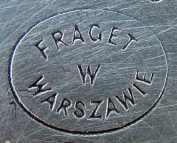 |
Marked by the inscription "FRAGET W WARSZAWIE" ("FRAGET
IN WARSZAW") placed in the oval. The size of the oval is
8x10 mm. The "N" in the rhomb means "Silver plating on
Alpacca". In the small oval there is the coat of arms of
the coppersmiths' corporation (two crossed hammers with
a pair of compasses). The lettering "GALW" means "GALWANIZACJA"
(in Polish) or "GALVANISATION" (in English). Note the
colon after the "GALW" lettering.
|
4
|
1860-1872
|
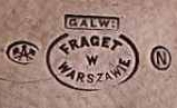 |
Marked by the inscription "FRAGET W WARSZAWIE" ("FRAGET
IN WARSZAW") placed in the oval. The "N" in the oval
means "Silver plating on Alpacca". In the third oval
there is the coat of arms of the coppersmiths'
corporation (two crossed hammers with a pair of
compasses). The lettering "GALW" means "GALWANIZACJA"
(in Polish) or "GALVANISATION" (in English). Note the
colon after the "GALW" lettering.
|
5
|
1872-1896
|
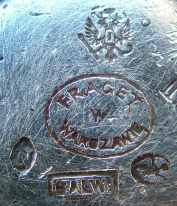
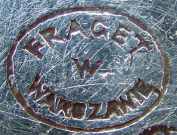 |
Marked by the inscription "FRAGET W WARSZAWIE" ("FRAGET
IN WARSZAW") placed in the oval. The size of the oval is
7.5x10 mm. The "N" in the rhomb means "Silver plating on
Alpacca". In the small oval there is the coat of arms of
the coppersmiths' corporation (two crossed hammers with
a pair of compasses). The lettering "GALW" means "GALWANIZACJA"
(in Polish) or "GALVANISATION" (in English). Note the
colon after the "GALW" lettering. The coat of arms of
the Russian Empire (double-headed eagle) on the mark
means a gold medal at the All-Russia Exhibition of
Manufactured Goods or the sign of the official purveyor
to the Court of His Majesty Russian Tsar.
|
6
|
1896-1915
|
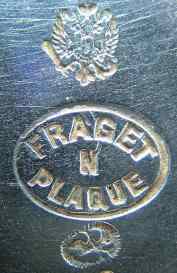
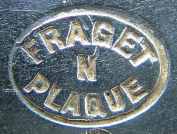 |
Marked by the inscription "FRAGET N PLAQUE" (which
means "FRAGET SILVER PLATE ON ALPACCA"), placed in the
oval. The size of the oval is between 7x9 mm and 8x11
mm. In the small oval there is the coat of arms of the
coppersmiths' corporation (two crossed hammers with a
pair of compasses). The coat of arms of the Russian
Empire (double-headed eagle) on the mark means a gold
medal at the All-Russia Exhibition of Manufactured Goods
or the sign of the official purveyor to the Court of His
Majesty Russian Tsar.
|
7
|
1896-1915
|
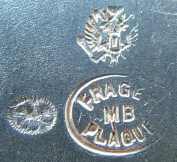
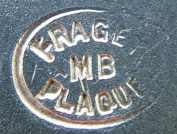 |
Marked by the inscription "FRAGET MB PLAQUE" which
means "FRAGET SILVER PLATE ON METAL BLANC (WHITE
METAL)", placed in the oval. The size of the oval is
6.5x8.5 mm. In the small oval there is the coat of arms
of the coppersmiths' corporation (two crossed hammers
with a pair of compasses). The coat of arms of the
Russian Empire (double-headed eagle) on the mark means a
gold medal at the All-Russia Exhibition of Manufactured
Goods or the sign of the official purveyor to the Court
of His Majesty Russian Tsar.
|
8
|
1896-1915
|
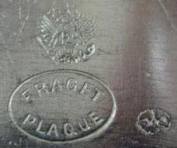 |
Marked by the inscription "FRAGET PLAQUE" (which
means "FRAGET SILVER PLATE"), placed in the oval. In the
small oval there is the coat of arms of the
coppersmiths' corporation (two crossed hammers with a
pair of compasses). The coat of arms of the Russian
Empire (double-headed eagle) on the mark means a gold
medal at the All-Russia Exhibition of Manufactured Goods
or the sign of the official purveyor to the Court of His
Majesty Russian Tsar.
|
Norblin marks (my own
classification)
|
N°
|
PERIOD
|
NORBLIN MARK
|
COMMENT
|
9
|
around 1850
|
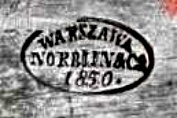 |
Marked by the inscription "WARSZAWA NORBLIN & Co" +
the year of production, placed in the oval.
|
10
|
after 1850
|
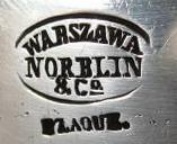 |
Marked by the inscription "WARSZAWA NORBLIN & Co" +
the year of production, placed in the oval. The
expression "PLAQUÉ" means "PLATED" in French.
|
11
|
Before
1872
(or after
1893)
|

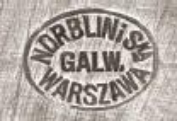 |
Marked by the inscription "NORBLIN i Ska (which
means NORBLIN i SPÓLKA or NORBLIN & Co) + GALW. +
WARSZAWA", placed in the oval. The lettering "GALW"
means "GALWANIZACJA" (in Polish) or "GALVANISATION" (in
English). Note the dot after the "GALW" lettering. The
letter "B" means "Britannia Metal", the material of the
base.
|
12
|
1872-1893
|
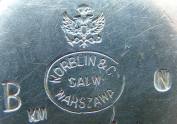
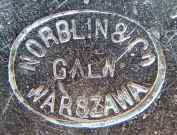 |
Marked by the inscription "NORBLIN & Co + GALW. +
WARSZAWA", placed in the oval. The size of the
inscription is about 9x12 mm. The lettering "GALW" means
"GALWANIZACJA" (in Polish) or "GALVANISATION" (in
English). Note the dot after the "GALW" lettering. The
"N" in the oval means "Silver plating on the base
metal". The letter "B" means "Britannia Metal", the
material of the base. The coat of arms of the Russian
Empire (double-headed eagle) on the mark means a gold
medal at the All-Russia Exhibition of Manufactured Goods
or the sign of the official purveyor to the Court of His
Majesty Russian Tsar.
|
13
|
before 1915
|
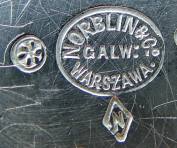
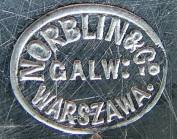 |
Marked by the inscription "NORBLIN & Co + GALW: +
WARSZAWA.", placed in the oval. The size of the
inscription is about 8x11 mm. The lettering "GALW" means
"GALWANIZACJA" (in Polish) or "GALVANISATION" (in
English). Note the colon after the "GALW" lettering and
the dot after "WARSZAWA". The "N" in the rhomb means
"Silver plating on Alpacca".
|
14
|
after 1915
|
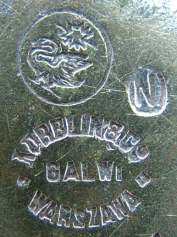
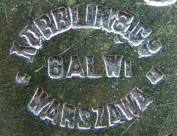 |
Marked by the inscription "NORBLIN & Co + GALW: +
WARSZAWA", without the oval. The size of the inscription
is about 7x9 mm. The lettering "GALW" means "GALWANIZACJA"
(in Polish) or "GALVANISATION" (in English). Note the
colon after the "GALW" lettering. Also, there is no dot
after "WARSZAWA". The "N" in the oval means "Silver
plating on Alpacca"
|
LITERATURE
1. Svetlana Chestnykh: Fraget: The history of the firm.
Antikvarnoye Obozrenie (Antiques Review), No.2, pp.34-35 (2001)
[in Russian].
2. Svetlana Chestnykh: Generally accepted designations in Polish
silver plate marks. Antikvarnoye Obozrenie (Antiques Review), No.1,
pp.28-29 (2001) [in Russian].
3. Svetlana Kaikova: Silver plate in Russia. Makers and
factories. Antikvariat, Predmety Iskusstva i
Kollektsionirovaniya (Antiques, Art and Collecting), No.1, pp.65-78
(2002) [in Russian].
4. Wincenty Norblin (Vincent Norblin), http://pl.wikipedia.org/wiki/Wincenty_Norblin
[in Polish].
5. Ludwik Wincenty Norblin (Ludwig Norblin), http://pl.wikipedia.org/wiki/Ludwik_Wincenty_Norblin
[in Polish].
6. Norblin (History of the Factory), http://www.norblin.eu/index.php?go=historia
[in English].
Prof. David N. Nikogosyan,
University College Cork, Cork, Ireland
- 2009 -
|
|
|
 ASSOCIATION OF SMALL COLLECTORS OF ANTIQUE SILVER
ASSOCIATION OF SMALL COLLECTORS OF ANTIQUE SILVER ASSOCIATION OF SMALL COLLECTORS OF ANTIQUE SILVER
ASSOCIATION OF SMALL COLLECTORS OF ANTIQUE SILVER